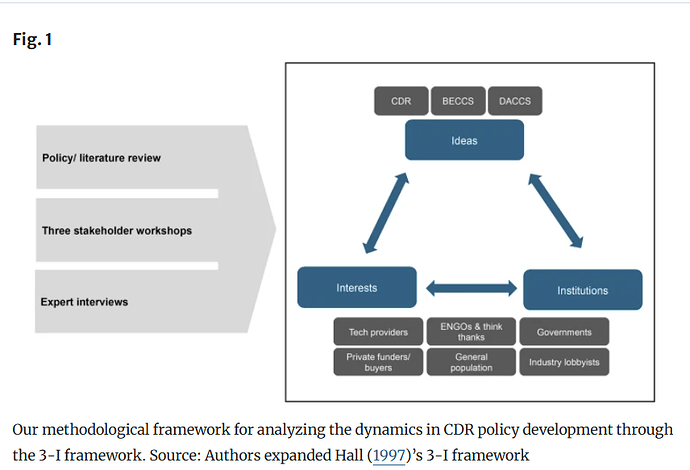In a recently published article, ‘Effective and Fair Policy to Mobilize Industrial Carbon Dioxide Removal’, Soyoung Oh, Samuel Eberenz, Matthias Honegger, Olia Wallis, Alex Michaelowa and Matthias Poralla have studied contradictory norms and synergies impacting policymaking used to catalyze the deployment of biomass combined with carbon capture and storage (BECCS) and direct air capture with storage (DACS) with a focus on Germany. In doing so, they expanded the 3-I framework used by Hall.
Key takeaways:
- Governments should strike a balance between policies that increase demand such as carbon contracts for difference and procurement and those that boost the efficiency of production such as research and development investment in order to create favorable conditions for BECCS and DACS deployment at a national level.
- The adoption of this approach would mitigate sector-specific risks and drive demand for CDR.
- That said, governments should also prevent the generation of extravagant profits by assessing the costs incurred by CDR deployment on an ongoing basis and decrease the amount of subsidy provided for future CDR deployment if necessary.
- In addition, governments should put in place policies tailored to the exigencies of BECCS and DACS technologies without overly relying on market competition in order to ensure that financial benefits of CDR deployment can be dispersed and novel technologies can be developed.
- Governments should support various BECCS and DACS technologies across a spectrum of different levels of maturity insofar as they refrain from providing subsidies for technologies that consistently fail to deliver any benefits. In doing so, they can allow actors that develop novel technologies to showcase their work notwithstanding the presence of stakeholders whose technologies have achieved growth.
- Revenues obtained from international carbon markets can play a key role in substituting governmental subsidies.
- Policy tools should prevent fossil fuel use with carbon capture and storage (CCS) from being locked in. Given that oil and gas companies prefer deploying technologies that are in line with their business scheme such as enhanced oil recovery (EOR), carbon takeback obligations should be regulated so as to ensure that such companies are not in a position to choose the CDR technology used to capture and store CO2.
- If the pursuit of the aforementioned path is not feasible due to the influence exerted by oil and gas companies, a minimum threshold should be established for the use of certain technologies such as basaltic mineralization.
- Policy tools should give weight to all co-benefits and negative effects of various types of CDR considering the impacts they generate across the entire value chain.
- The deployment of BECCS and DACS should be subjected to strict carbon accounting and monitoring, reporting and verification (MRV) requirements in cases where they benefit from financial incentives.
- Governmental policy support should not hinder competition between various CDR technologies.
Read the full article here: Effective and fair policy to mobilize industrial carbon dioxide removal | Mitigation and Adaptation Strategies for Global Change
